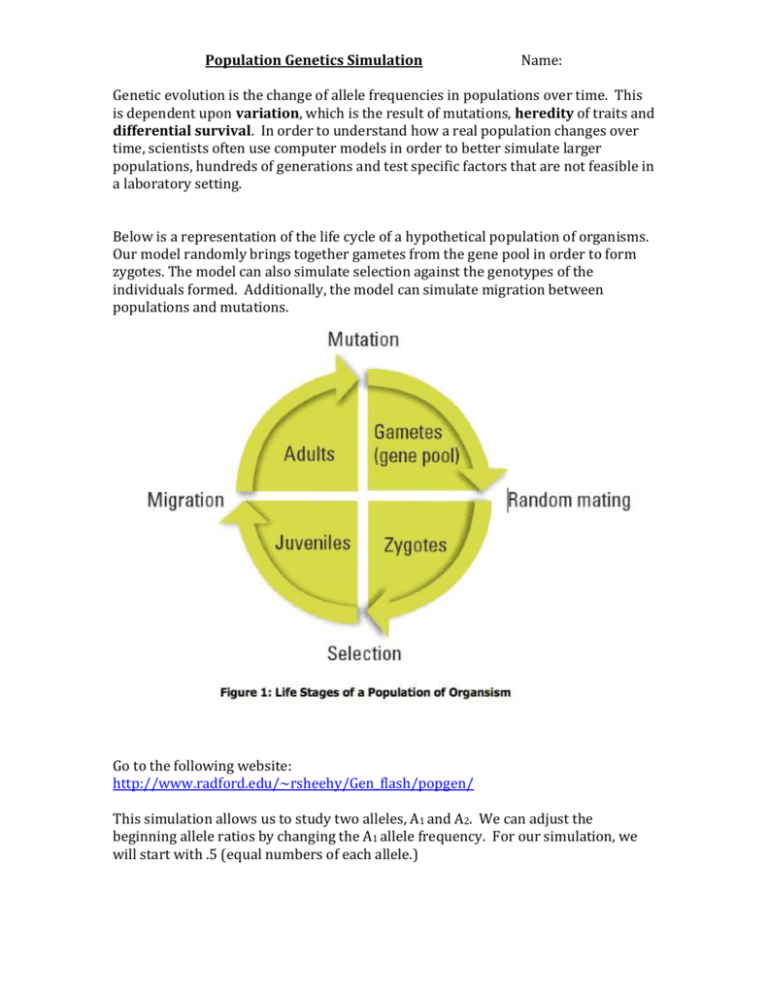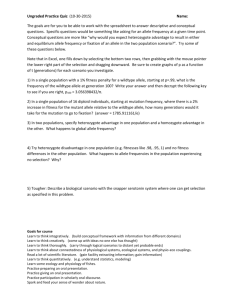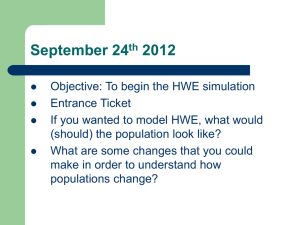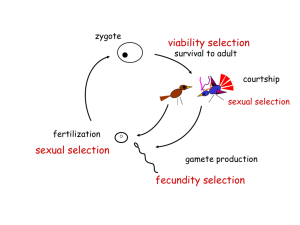File - Cook Biology
advertisement

Population Genetics Simulation Name: Genetic evolution is the change of allele frequencies in populations over time. This is dependent upon variation, which is the result of mutations, heredity of traits and differential survival. In order to understand how a real population changes over time, scientists often use computer models in order to better simulate larger populations, hundreds of generations and test specific factors that are not feasible in a laboratory setting. Below is a representation of the life cycle of a hypothetical population of organisms. Our model randomly brings together gametes from the gene pool in order to form zygotes. The model can also simulate selection against the genotypes of the individuals formed. Additionally, the model can simulate migration between populations and mutations. Go to the following website: http://www.radford.edu/~rsheehy/Gen_flash/popgen/ This simulation allows us to study two alleles, A1 and A2. We can adjust the beginning allele ratios by changing the A1 allele frequency. For our simulation, we will start with .5 (equal numbers of each allele.) Simulation 1: No Selection For the first part of this activity, we will be only looking at one population, so set the # of populations to 1. Increase the population size to 9000 individuals and leave the fitness at 1 for each genotype (meaning none gives a disadvantage). Make sure that you have 200 generations set and press ‘GO’. It may take a while because of the large population size. 1. What is the frequency of the A1 Allele (p)? _____ 2. What is the frequency of the A2 Allele (q)?_____ 3. What is the frequency of p2? _____ 4. What is the frequency of q2? _____ 5. What is the frequency of 2pq? _____ 6. Did your population evolve? Explain. 7. Did you expect this result? Explain. Simulation 2: Cystic Fibrosis (selection) Cystic fibrosis is a rare, recessive genetic disorder that usually results in death before an affected individual is able to reproduce. For our simulation, A1 will represent the healthy dominant allele and A2 will represent the recessive cystic fibrosis allele. We will keep the population size the same as for simulation 1, but because individuals with cystic fibrosis are unable to reproduce, their fitness will be reduced to 0. Reset and run the simulation. 1. What is the frequency of the A1 Allele (p)? _____ 2. What is the frequency of the A2 Allele (q)?_____ 3. What is the frequency of p2? _____ 4. What is the frequency of q2? _____ 5. What is the frequency of 2pq? _____ 6. Did your population evolve? Explain. 7. Did you expect this result? Explain. 8. Why is it difficult for the trait to become ‘fixed’ in this population? Will this trait eventually become fixed? Explain. Simulation 3: Sickle Cell Anemia (heterozygote advantage) Sickle cell anemia is a recessive genetic disorder that often results in death before an affected individual is able to reproduce. Individuals that are heterozygous for sickle-cell anemia, however, are not affected by the sickle-cell trait but are resistant to malaria. For our simulation, A1 will represent the healthy dominant allele and A2 will represent the recessive allele. We will keep the population size the same as for simulation 1, but because individuals with sickle-cell anemia are often unable to reproduce, their fitness will be reduced to .2. Since homozygous dominant individuals are more likely to the infected with malaria, reduce their fitness to .8. Reset and run the simulation. 1. What is the frequency of the A1 Allele (p)? _____ 2. What is the frequency of the A2 Allele (q)?_____ 3. What is the frequency of p2? _____ 4. What is the frequency of q2? _____ 5. What is the frequency of 2pq? _____ 6. Did your population evolve? Explain. 7. Did you expect this result? Explain. 8. Why is it difficult for the trait to become ‘fixed’ in this population? Will this trait eventually become fixed? Explain. Simulation 4: Genetic Drift Reset your simulation to the same settings as simulation 1 (all fitness at 1), but reduce the population size to 100. Reset and run the simulation. 1. What is the frequency of the A1 Allele (p)? _____ 2. What is the frequency of the A2 Allele (q)?_____ 3. What is the frequency of p2? _____ 4. What is the frequency of q2? _____ 5. What is the frequency of 2pq? _____ 6. Did your population evolve? Explain. 7. Did you expect this result? Explain. 8. Explain why this simulation had a different result from simulation 1. 9. Run the simulation 4 more times. How do the results compare to each other? Why are there differences each time? 10. Explain how evolution can occur even if there is no natural selection. Additional Simulations Create your own simulations to test the following scenarios and describe your results. Settings Results Explanation of Results Frequency of the A1 p? Selection Against Dominant Trait Frequency of the A2 q? Pop Size: Fitness Frequency of p2? A1A1: Frequency of q2? A1A2: A2A2: Frequency of 2pq? Did your population evolve? Generations to fixation? Other observations? Migration Between Populations Pop Size: Fitness A1A1: A1A2: A2A2: # of Populations: Frequency of the A1 p? Frequency of the A2 q? Frequency of p2? Frequency of q2? Frequency of 2pq? Did your population evolve? Generations to fixation? Other observations? Mutation Pop Size: Fitness A1A1: A1A2: A2A2: Mutation Rates: Frequency of the A1 p? Frequency of the A2 q? Frequency of p2? Frequency of q2? Frequency of 2pq? Did your population evolve? Generations to fixation? Other observations? Genetic Bottleneck Pop Size: Fitness A1A1: A1A2: A2A2: Bottleneck Settings: Frequency of the A1 p? Frequency of the A2 q? Frequency of p2? Frequency of q2? Frequency of 2pq? Did your population evolve? Generations to fixation? Other observations? Try out any other scenarios you want. Take your time to play with the simulation so you better understand how different factors interact with each other. Questions: 1. Do you think evolution occurs more quickly in large populations or small populations? Explain. 2. Why is genetic diversity important for the process of evolution? 3. Do you think genetic drift plays an important role in the evolution of certain populations? Explain. 4. Some scientists hypothesize that the human population experienced a bottleneck that reduced the population to around 15,000 individuals about 100,000 years ago. Describe how this event may have affected the current human population.









